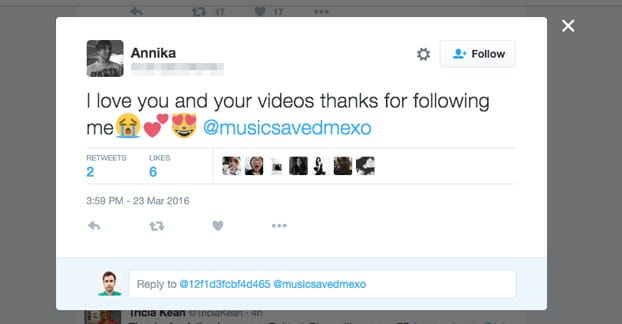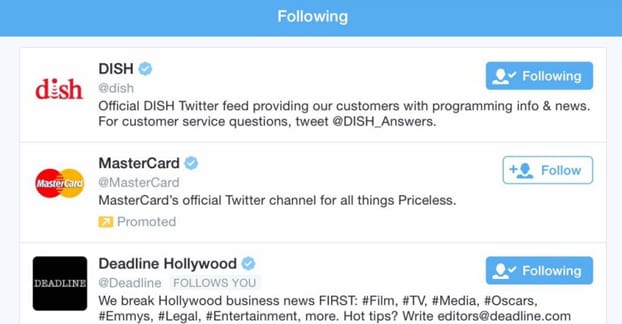Twitter is an interesting platform for social media because it’s inherently a little anti-social. What I mean by that is that, unlike every other social network, the connections between two people on Twitter are one-way by default. When a person follows you, you don’t have to approve that follow or follow them back. It just happens.
So, what happens when a user follows you, and what actions should you take? This is a surprisingly complex and nuanced topic if you’re a newcomer to Twitter. Taking the wrong actions can be seen as a faux pas and can hurt you in the long run.
What a Follow Does
First of all, on Twitter there is no differentiation between a business account and a personal account. There’s no page/profile difference like there is on Facebook, or anything of the sort. Some businesses and entities are verified, but that’s not necessarily true of all businesses, and it’s not something you should worry about when you’re first starting out. Unless you’re a celebrity, in which case you should seek out verification just so people know you’re not an imposter. Also, if you’re a celebrity, shoot me a message; I’d love to hear from you.
When a user follows you on Twitter, what they’re doing is subscribing to your feed. When you post something, it shows up in their feed on the Twitter homepage or in whatever app they’re using. They may not actually see the tweet, of course; if the user follows hundreds of people it becomes impossible to keep up with everything.
You do not need to approve a follow. If you want, the interaction can end there. You don’t need to look at their profile, you don’t need to care who they are, and you don’t need to follow them back. That said, there are some good reasons to take some further actions, so let’s look at them.
Step 1: Determine the Quality of the Account
What I like to do when someone follows me is visit their profile to see who they are and what they represent.
There are a few different kinds of accounts that might follow you.
- Faceless and meaningless bots. These accounts typically have no information filled out in their profiles, or very little. They often have the egg account avatar a new registrant has, and they haven’t posted anything. Occasionally these accounts are real people following you but not caring about using Twitter themselves. Most of the time, though, they’re fake users.
- Bots that are advertising something. These are bots that monitor search results for hashtags or keywords, looking for something related to their industry. If you trigger one by using their keyword, they’ll follow you. When you visit their page, you see their feed is full of advertising for their business. It’s spam, fully automated, and not beneficial to you.
- Spam accounts that post whatever someone pays them to post. These are similar to the above, except they’ll probably have a bit more robust information because they pretend to be real people curating content. The reality is all the links come from a few similar spam sites, and the account itself never posts anything of its own value.
- Real people who follow you because they like you, your brand, or your content. These are beneficial followers, and you can tell because their profile will look real and lived-in. They have information filled out, they tweet regularly, and they have followers of their own.
- Businesses that want to form a relationship with you. These are business accounts that think you might be available for mutual sharing or some deeper relationship. They can be beneficial or they might be spam, and it depends entirely on the quality and industry of the business involved.
- Businesses that want you to buy from them. This is similar to the second entry on this list, but their business is a little less spammy and a little more legitimate. I still don’t think they’re very useful.
- Celebrities or influencers. These are the most beneficial followers you can get, because they have large audiences that will see anything of yours they share. By all means, take advantage of this relationship.
What you do in response to each of these will depend on what your purpose with Twitter happens to be. If you’re just there to post and don’t care about engagement, you can ignore all of them. If you want to maximize exposure and promote your business, you’ll have to take a more nuanced response.
Step 2: Follow or Block Depending on Quality
Let’s take the same list as above and go over the responses you can have for each type of follower.
- Faceless and meaningless bots. These I typically purge. They aren’t being beneficial to you because they aren’t retweeting or engaging with any of your posts. They don’t help you, they just exist to harvest follow-backs to then sell the account. You can also report them to Twitter if you want to get them removed from the site as a whole.
- Advertising bots. I purge these as well. They aren’t doing you any good; they’re just using you to hopefully get you to buy from their service. These bots also won’t engage with your tweets and won’t benefit you. Worse, they might use you as a vector to get at your other followers. Remove them, block them, and report them to get them removed from Twitter as a whole.
- Spam accounts. These tend to be removed on their own after a short time, either because they’re trying to follow/unfollow for their own growth or because spam reports get them removed from the site. It’s up to you if you want to keep them around or not. I keep a few around because they’re amusing, but most I just block and report.
- Real people. These folks are great to keep around, but aren’t beneficial enough to follow back. They often don’t care much about followers themselves. They aren’t bad enough to warrant a block or a report, but they aren’t good enough to warrant a follow in return. Nothing says you can’t follow them, of course. I just don’t think it’s necessary.
- Business relationship seekers. This really depends on whether or not you want to form a relationship with the business in question. If they’re a good business and you think the relationship would be beneficial to all parties involved, by all means, go ahead and follow them back. If their business isn’t relevant or you don’t think they can bring anything to the table that you want, you can ignore their follow and any messages they send at you. If you want to be a little sneakier, you can lead them on or pretend you’re interested but never actually act on it. You might even get some value out of it before they catch on.
- Businesses seeking your business. If the business is potentially valuable, investigate it to your heart’s content. If not, ignore them. They won’t hurt you and they’ll probably unfollow you if they realize you aren’t going to buy from them.
- Influencers. Go out of your way to engage with these people. One retweet from an influencer can bring you more business and traffic than a month of engagement from regular users, and with more conversions as well. Influencers deserve a follow-back and retweet at the very least.
Step 3: Thank Them For Following
It’s generally considered to be bad form to create a bot that automatically sends a thank you message to anyone who follows you. For one thing, it tells people you’re automating your social presence, which makes them less likely to engage with you over time. For another thing, it hits accounts that are otherwise spam. It’s alright if it’s a DM and thus hidden, but if it’s a public “Thanks @user for following!” it gets really dumb when they’re spammers.
I recommend sending a “thanks for the follow” message only in a direct message, and only if the user is an influencer or business who is legitimately following you. Anyone fishing for followbacks, anyone who is a spammer or bot, or anyone who is a low-presence normal user doesn’t need that kind of special attention.
Step 4: Connect on Other Social Networks
For cases where the person following you has a robust internet presence and they’re someone you want to keep in touch with – like an influencer or a business partner – you should track them down on other social networks and offer connections there. Business partnerships can spring up on Twitter but you can really solidify them by tracking them down and adding them on LinkedIn as well. Influencers you can invite to follow you on Facebook, as well as follow them in return. If you both happen to use Triberr or some other niche network, forming an alliance there can be very beneficial for that narrow band audience.
Step 5: Consider a DM to Pitch Your Service
In general, as a business, sending out a direct message can be somewhat spammy. Most people casually using Twitter don’t anticipate seeing direct messages anywhere other than from friends. Getting one from a business automatically comes across as spam.
The one exception to this is when you really think the follower in question might be interested in your business. Usually you’ll be able to tell this, either because you recognize them from other sales channels, or you see posts they have made about you. If you legitimately think the user might be interested in buying something from your store, shoot them a DM pitching your service or product selection.
The key here is to customize the message as much as possible. Thank them by name and reference something they have posted in regards to you. If possible, incentivize their purchase by providing a unique discount or coupon code. If your message is valueless spam people will delete it and maybe even block you or unfollow you. If it’s valuable, it seems personal and they’re more likely to buy.
Step 6: File Into a List if Necessary
If you do choose to follow back the people who follow you, I highly recommend adding them to a list. In fact, you can add them to lists instead of following them. I recommend making a few lists you maintain privately. These lists can have rough categories like “minor influencers,” “major influencers,” “regular followers” and the like. Of course, you can categorize them however you want.
My main use of lists is to manage the feeds I see. I have one major list of people who produce great content, which allows me to look in one place for inspiration and curation. I have another for tertiary inspiration, and one for people I want to acknowledge occasionally but don’t want to see in my feed all the time. How you set it up for yourself is up to you.
Step 7: Check to See if They Still Follow You
Whenever someone follows you, note them down. I like to make a bookmark folder, because it’s simple and easy to check. When someone follows you, visit their profile and bookmark it in that folder.
Now, a week or two later, go back to their profile and check to see if they still follow you. If they do, good; keep them around and remove the bookmark. If they don’t, you know something is up. They might have been fishing for a follow, they might have been turned off by something you said, or they might just not know what they’re doing. If they unfollowed you and you followed them, feel free to unfollow them in return.
Step 8: Respond to Mentions and Engagement
Once you’re done tinkering with followers and follow audits, you have to focus on maintaining your presence. One of the best ways to do this is to respond to the engagement that comes your way. Monitor your influencers and retweet/comment on the interesting things they share. Whenever anyone mentions you or replies to you, respond to their post. It might be a simple “thanks for your thoughts” or it might be the start of a longer conversation.
This also gives you an opportunity to respond to any negative posts or customer criticism, which helps foster brand loyalty when you correct issues and offer to make things right. Never underestimate the value of being helpful.









How do I mention my book without trying to sound promotion-greedy? I know I need to create awareness but how without breaking an egg-shelled twitter rule?
Hi Judith! You could give away free chapters, run contests to give away free copies of your book, quote parts of your book – there are a lot of ideas like this that provide value without just shamelessly promoting your book. Best of luck!